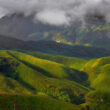Get lost in the white cities of Puglia: If you are already in Puglia in southern Italy, then it is worth driving through small towns – this is easy to do even without a car. To understand this region from the inside, it is best to choose one port city, and another closer to the center of agritourism and stop by an Italian estate with the beautiful name “Masseria”. Monopoli and Ostuni will be the best choice for such a trip.
Located just an hour away by train from each other, these are two white-washed labyrinthine cities. But their energy is completely different: in Monopoli, a breeze walks through the streets and it seems that even the walls of the streets are deeply saturated with Adriatic salt. Ostuni is a fortified city on a high hill, which can be seen for many kilometers. There, you seem to be transported to another reality, where agriculture was preferred to fishing, and quaint trulli houses were preferred to coastal shacks.
Garibaldi Monopoli Square

Start your day with breakfast in the main square of the old town, Piazza Guiseppe Garibaldi. Here you will see a scattering of cozy cafes with beige awnings and starched tablecloths. The foliage of the trees casts graphic shadows on the paving stones, a light breeze comes from the port, and you can go up to the old “Fontanella” to refresh yourself with cool spring water. Sit at the table you like. For an excellent cappuccino, take homemade pannacotta with strawberry sauce and try to order in Italian – the waiter will not leave this gesture unattended. In the corner of the square is the city library. Exhibitions are held there several times a year, and in the courtyard, you can hide from the scorching sun and peep how the local youth spend their time. One of the arches near the library will lead you to the old port.
Old Port of Monopoli

Monopoli Port is the real heart of the city, this port is unlike any other. Here you want to sit by the water in the first row – it will seem that you are watching a movie, and time stops. Green shutters, neat balconies, wrought-iron lanterns, monochrome stone walls, and along the shore – colorful red and blue Gozzi boats with small Italian flags. Someone will definitely ride a bicycle around the parapet, an elderly Italian couple on the bench opposite will emotionally discuss something, and a person will definitely sit motionless somewhere in silent contemplation. Italians treat this place with special trepidation: after all, it was here that the Madonna once appeared.
The port is surrounded by the walls of the Martinelli Palace and Monopoli Castle. The Martinelli Palace was built in the 18th century in the Neo-Gothic style – it is decorated with eight arches. The castle was built in the 15th century the fortress was part of the conquests of the king of Spain, Charles V. The majestic towers served as a home for military families, and later prisoners were kept here. Today the castle has become an exhibition center. There are impressive bas-reliefs on the walls, which recreate the stories of heroic deeds and tragedies known throughout the world. In August 1971, a fire broke out on the Greek ship Galeana 15 miles from the port. Then the local fishermen bravely rushed to save the passengers.
Cala Porta Vecchia beach

Walk a little forward from the old port along the embankment. You will see how a narrow strip of beach frames the fortress wall. Old fishing nets hide under the sun-warmed stoves and shy crabs run through. The water here is surprisingly clear and changes its shades with a gradient from pale blue to deep blue. Carefully enter the sea, leaning on sloping stones. Having sailed a little away and suddenly turning around, one cannot help but admire such a beautiful contrast of nature and architecture.
Monopoli old town

On the narrow streets paved with “chianche” – a white stone typical of the south of Italy – you want to breathe in the sea air. It mixes with the aromas that come from almost always open slaves: the smell of freshly washed laundry and meatballs cooked for dinner in garlic-tomato sauce. These houses were once inhabited exclusively by fishermen, whose grandchildren mend fishing nets to this day.
Monopoli is filled with artisan workshops and all sorts of grocers – in the old town, everything should be within reach of the front door. Every now and then you find yourself in small squares surrounded by centuries-old shabby facades. The Italians call it the poetry of antiquity, Paese Vecchio. or go to another church. The cries of seagulls, pastel colors, vibrant tastes, and bustle of the streets reflect the values of the Mediterranean and Eastern tradition.
Sottocoperta

It’s time to try the fish specialties. The Sottocoperta restaurant is conveniently located near the fortress wall overlooking the old port. It got its name from the part of the ship where sailors take shelter in a storm. The owners of the restaurant tried to create a place where guests feel at home. It includes a hall with ancient arches and a terrace – a large balcony for several tables. The interior is reminiscent of a ship’s cabins, with rough wooden furniture and cobweb-like nets hanging from the ceiling. In such places, it is worth ordering what a sailor could choose – a simple and hearty meal. For example, an olive oil toasted bun with soft cheese, juicy tomatoes, and the freshest tuna and local unfiltered beer in a huge glass. Average check: 10-12 euros
Ostuni

The history of this small snow-white town is impressive – the area around it was inhabited by the Messap tribes back in the Stone Age. But after Hannibal destroyed them during the Punic Wars, the Greeks founded their colony here. The settlement was named Ostuni, which in Greek means “new place” – astu neon. The city was built on a hill for a reason – for better protection from invaders – and is a labyrinth of descents and ascents. Now, Ostuni can be easily reached by train – it is conveniently located on the main road from Bari to Lecce. The journey takes 45 minutes from Bari. It should be borne in mind that the station is located about 2 km from the city center, and if you don’t feel like walking, you can take a bus or minibus, which regularly leave directly from the station.
The old town of Ostuni

Ostuni is often called the white signora. According to legend, during the plague, local healers found out that lime had to disinfect properties. They decided not only to treat the sick with it but also to cover all the buildings in the city with lime to avoid the spread of infection. Later, even a law was passed not to use other colors and to regularly renew the paint. Another important advantage is that the white color reflects the rays of the sun so that even in the heat it is quite cool here. Ostuni is a city where it is ideal to come for one day. The old part with whitewashed houses, massive walls, and towers can be walked around in just an hour.
The higher up the steep streets, the narrower the distance between the walls – sometimes it reaches up to half a meter. Cars don’t drive here only three-wheeled cycle-rickshaws bring tourists lost in the labyrinth of streets. Souvenir shops and taverns are scattered here and there, and on the highest point of the old city stands the Cathedral of the Assumption of the Virgin, erected in the 15th century – the most important monument of Ostuni. Be sure to go inside and wander lazily through the labyrinth of streets surrounding the cathedral.
Nuova Coli pottery shop

Pottery is well developed in the Puglia region, so take a closer look at clay and ceramic products covered with traditional ornaments. In Ostuni, literally at the central square of Garibaldi, there is a large ceramics store Nuova Coli Ceramiche. Once, back in 1650, it was a pottery shop, where Andrea Coli worked as a craftsman and created clay pots. Now Nuova Coli is one of the most famous companies for the production of majolica and terracotta, which includes two areas. One of them is Maiolica Forte, which produces impact-resistant clay products.
The secret is that the firing takes place at an ultra-high temperature of 1050 degrees. The second direction is Terra&Fuoco dealing with crystal trays. Inside the shop, eyes widen – dozens of plates, bowls of different depths, dishes, and cups huddle on the floor and shelves. There are also jugs, sets of salt and pepper shakers, and baking dishes – you just want to buy several items at once and, having brought home, cook something from Italian recipes. The colors are very diverse – from classic rustic patterns to whimsical patterns imitating ink stains. The prices are quite pleasant and range from 2-50 euros. Average bill: 10 euros
Cicinedda Fruit Bistrot

On Corso Vittorio Emmanuele, a beam from Ostuni’s main square, Cicinedda is a charming family place, perfect for breakfast or a leisurely lunch. During the day, you can meet friendly and smiling owners at the counter who will definitely recommend the freshest dessert, and instead of tea, they will jokingly offer you a glass of wine. Even this small cafe has a history – it is a family business that is almost 50 years old. Three children watched all their childhood, how their grandfather, and then their father, received guests here, and now they are inspired to continue the work themselves, constantly bringing something new.
They lovingly refer to Cicinedda as “fruit bistro”. Indeed, in addition to salads and classic appetizers, the menu is dominated by fresh fruits – there are about twelve types of smoothies alone. Entering the cafe from the main street, feel free to go through it – in addition to the main hall on the parallel street Via Cassiodoro, there is another entrance. There, in the shade of the trees, there are several low tables and chairs with cushions and it is somehow cozy in a special way. The average check is 7-10 euros.
Masseria Salinola

Puglia can be called the center of agrotourism. Italian estates even have their own name – Masseria. Here, life is centered around agriculture: small houses are made in the old Italian style, and their inhabitants grow vegetables, fruits, cook their own olive oil, burrata, mozzarella, and, of course, wine. It is best to go to a family Masseria – for example, Masseria Salinola. It has existed for over 100 years. You can easily get here from the center of Ostuni by taxi in just fifteen minutes. Masseria Salinola is built according to the ancient traditions of the farm, which it has been since the 16th century.
The central building, the tallest, was assigned to the farmer, and servants and workers lived in smaller houses. Later, a swimming pool appeared here, behind which there is a vegetable garden, olive groves, and small buildings for pets: you will see chickens, rabbits, and even a peacock with a regal gait. As soon as the gate opens, you find yourself in an autonomous world of peace and quiet. On the left is a small chapel, in the middle of the courtyard, brushwood is neatly folded – a fire is made every evening. Antiquities are reverent here: starched sheets, textiles made from natural materials, lace, vintage furniture, aged drawers at the foot of the bed. Everything has an elegant simplicity. It is good to spend a weekend in Masseria, but you can also stop by for lunch, candlelit dinner.
The restaurant is a special pride of the estate: the owner herself cooks here according to homemade recipes. Be sure to try the olive oil prepared right here, orecchiette and baked rabbit with Mediterranean sauces and seasonings of rosemary, tomatoes, olives. And you can spend the day by the pool or relax in the jacuzzi for 35 euros. The price includes a welcome drink, towels, Wi-Fi, and herbal tea. Additionally, you can even book a massage. It is better to let the hotel know in advance, as in order to maintain a unique atmosphere for visiting, the owners prepare only a few places per day for guests. Average check: 35 euros It is better to specify the time for visiting individually upon request in advance
Observation deck overlooking Ostuni

Returning from Masseria at sunset, do not rush to reach the main square. Leave a little earlier and be sure to stop at the observation deck on Corso Vittorio Emanuele II. In the distance, on a hill, a white city will appear in front of you, birds will circle around it, and, if you’re lucky, the bells of the towering chapel will sound. And in the evening, when the lights come on, the old city will look like a bar of gold in the dark. Below is a winding road that will add a cinematic feel to the moment.
Restaurant White Ostuni Tito Schipa
From the lookout, head to the White Ostuni Tito Schipa restaurant for dinner on Corso Vittorio Emanuele II. Tito Schipa is the name of a famous Italian tenor who was once a frequenter of the Lucia cafe, located in 1936 on the site of the restaurant. The owners decided to pay tribute to the traditions and preserve the memory of the heritage. This place is perfect for a cocktail on the terrace, for a special dinner, or to end the evening with a local bottle of wine with some typical appetizer. In this region, zucchini is especially reverent – try it baked in cheese.
According to Italian tradition, bread with olive oil will be brought to you – in each place, Apulian bread is baked according to their own recipes. It’s so good that I want to ask you to wrap a couple of pieces with you. It is also worth trying fish: salmon, tuna, grilled sea bass, fresh tartar. Even a simple pasta with shrimp exceeds expectations – however, in the south of Italy it is always like this: the simpler, home-style, the tastier. On weekends, DJs are invited here, gathering partygoers and travelers from all over the world. Average check: 20-25 euros
Ostuni’s main town square Piazza della Libertà

This is Freedom Square – the border of the old city and buildings of more modern architecture. Majestic palazzos, neoclassical churches with rococo elements, round towers that protected the city from attacks, fascinate at first sight. As the sun sets, the buildings change color from beige to gold. In the middle rises the spire of St. Oronzo, who protects the city from harm. The Italians believe that it was he who protected Ostuni from the plague. On August 26, a feast of reverence for the Saint is held: the statue is carried throughout Ostuni, arranging folklore performances and horseback processions.
Gelateria Cremeria Alla Scala

Going down the stairs to a small square with music coming from, you will find the best ice cream in Ostuni, where even locals come to stand in line. This is handmade ice cream with incredible flavors: slightly bitter cherry, orange almond, refreshing lemon, black chocolate cream! There’s even a brioche, a bun with a scoop of ice cream inside: it looks like the Italians couldn’t resist pairing two of their favorite treats: pastries and gelato. Average check: 2 euros for one horn
Similar Articles








